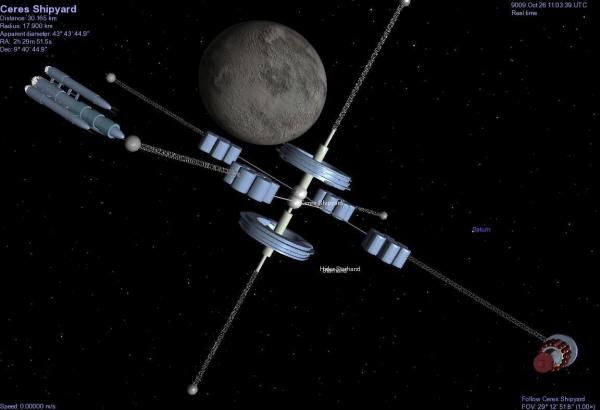BY LETTER
Shipyards and Spacecraft Repair Facilities
Technology > Application > Transportation > Interplanetary Transport
Technology > Application > Transportation > Interstellar Transport
Technology > Application > Manufacturing
Technology > Application > Megascale Engineering
Technology > Application > Transportation > Ships
Technology > Application > Transportation > Interstellar Transport
Technology > Application > Manufacturing
Technology > Application > Megascale Engineering
Technology > Application > Transportation > Ships
 Image from Steve Bowers | |
| Shipyards around Vesta | |
Shipbuilding and spacecraft repair facilities are very diverse, from stations that simply supply fuel and carry out minor repairs, to massive construction swarms. The end pruducts are diverse too; from the specialist NoCoZo yards that process small asteroids to build bespoke hulls for racing yachts, to the Biopolity liveship "spawning grounds" where pregnant bioships go to give birth and receive neonatal care. On a larger scale linelayers are constructed in systems with dense godtech infrastructure swarms, often near a weylforge which can create nanoscale wormholes for delivery.
 Image from Steve Bowers | |
| A Tigersplice warship under repair in an airdock owned by the Shipwright's Commune. The airdock is filled with an inert gas to assist cooling and prevent vacuum welding | |
Modern spacecraft are built or serviced in orbital factories. Often cylindrical they resemble non-rotating O'Neill hab at first glance. The outer hulls are covered in mattercache tanks and docking towers where supply craft bring in raw material from local asteroid belts, disassembled planets or Sunminer scoopships. The cylinder walls incorporate a series of layers in which smaller, more specialised fabricator cells take in feedstock or small, ready-assembled components and produce larger components. Any components which require forging at high temperatures are also created here.
The centre of each cylinder is hollow, housing the final assembly chamber. Thousands to millions of dendriform robotic arms reach into the chamber and manipulate the large components synthesised by the assembly layers to connect them together. These robotic arms are generally figured into Effector Frames specialized for space construction; these fill a significant portion of the open central cavity. Frames of this kind can form limbs of any type required (for moving components, operating omnitools, etc.), conduits of multiple sizes (including capillary networks for getting into hard to reach places) for moving coolant or other liquids or powderform materials around, walls if those are needed, and so on.
The Frames also transport energy feedstocks, replacement batteries and other power-storage media to the many different sizes and types of secondary microbot optimized for orbital construction. Swarms of bots fly or crawl around the vessel under construction or repair in order to get into all the nooks and crannies. To allow these bots to move freely the facility is often pressurised with an atmosphere; this atmosphere is generally an inert gas such as helium (the second most abundant element in the universe). In many cases, the bots are hybrid extensions of the effector frame itself, made of a combination of specialized components and ufog combined in various ways.
Very large shipyards sometimes resemble a massive set of panpipes, or a harmonica, with bundles of cylinders stacked together. They may be found in stationary orbit around a resource-rich planet or other object, deploy space elevators and counterweights and continually siphon material into space in order to fabricate fleets of ships or smaller numbers of very large craft.
 Image from Steve Bowers | |
| Ceres Shipyard | |
Smaller shipyards and service facilities include much of the same technology, but in smaller quantities, sufficient to repair and resupply a ship after a long interstellar voyage and prepare it for another similar journey lasting decades.
Related Articles
Appears in Topics
Development Notes
Text by Ryan B, Todd Drashner, rom65536, Steve Bowers
Initially published on 13 January 2017.
Initially published on 13 January 2017.






